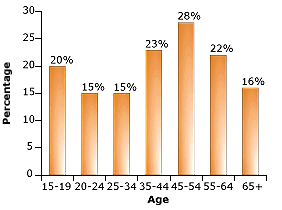
Canada's informal caregivers
CMAJ 1999;160:1427
© 1999 Canadian Medical Association
The Canada Health Monitor's August 1998 survey found that 20% of extended families in Canada have used health-related services in the home in the past year and 38% expect to use them in the next few years. Almost a third (31%) use or expect to use short-term rehabilitation services, and the same proportion use or expect to use elder care — services for people who are elderly and frail but want to live at home.
Twenty percent of Canadians care for family members and others either at home or elsewhere. Caregivers tend to be baby boomers, with the highest percentage (28%) found in the 45-to-54-year age group.
Almost two-thirds of informal caregivers (63%) care for 1 person but 22% care for 2 people and 9% care for 3 or more people. On average they spend 2.9 hours per visit with the care recipient. Among survey respondents, 7% said they themselves needed care; of those, 11% felt they would be better off in special housing.
The most frequently cited type of care being provided by the caregivers was taking people to doctors' appointments or visits with friends; assistance of this kind was mentioned by 58% of all caregivers, followed by providing help with financial affairs (30%) and keeping track of medication and medical supplies (22%).
Community services that are being provided do not appear to be meeting needs. Depending on the program, 10% to 30% of caregivers reported that the care recipient did not receive enough community services.
|
This column was written by Lynda Buske, Chief, Physician Resources Information Planning, CMA. Readers may send potential research topics to Patrick Sullivan (sullip@cma.ca; 613 731-8610 or 800 663-7336 x2126; fax 613 565-2382).
|
|
Send a letter to the editor Envoyez une lettre à la rédaction |
Autres chroniques Médicogramme |

